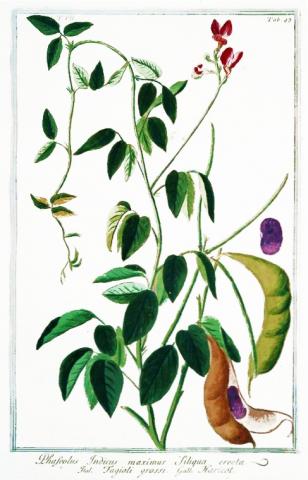Phaseolus vulgaris

| Common Name | Dry Bean
|
|---|---|
| Genus | Phaseolus
|
| Species | vulgaris
|
| Ploidy | Diploid
|
| Chromosome Number | 2n = 11
|
| Genome Size | 587Mbp
|
| Taxonomy | cellular organisms; Eukaryota; Viridiplantae; Streptophyta; Streptophytina; Embryophyta; Tracheophyta; Euphyllophyta; Spermatophyta; Magnoliophyta; Mesangiospermae; eudicotyledons; Gunneridae; Pentapetalae; rosids; fabids; Fabales; Fabaceae; Papilionoideae; Phaseoleae; Phaseolus
|
Dry Bean are high in protein and dietary fiber, as well as being an excellent source of iron, potassium, selenium, molybdenum, thiamine, vitamin B6 and folate. Dry beans take longer to cook then most pulses, although cooking time can be shortened by soaking dried beans before cooking. Dry Bean is a highly variable species with growth habits ranging from bush varieties growing 20-60cm tall to vine varieties growing 2-3m long. Seeds range from the small navy (think baked beans) and black types to the larger pinto and yellow types. In SK we do not currently breed large-seeded beans such as kidney beans.
-
 Kirstin E. Bett: Breeding dry (common) bean and conducting related genetics research on bean and lentil in collaboration with colleagues.
Kirstin E. Bett: Breeding dry (common) bean and conducting related genetics research on bean and lentil in collaboration with colleagues.
Size, shape and colour appropriate for market class, early maturity and, of course, yield. Marker-assisted selection for CBB and anthracnose tolerance.
Pre-breedingGenetic variability underlies all breeding efforts. Sometimes you have to go outside the primary genepool to find increased levels of variability. Tepary bean (Phaseolus acutifolius) is known to contain genes for traits of interest to common bean breeders such as disease resistance, increased micronutrients, and tolerance to abiotic stress (heat, cold, drought). Interspecies hybridization between tepary and common bean has led to the development of introgression lines which are being assessed for various traits. Lines with interesting phenotypes may be used as parents in the regular breeding program.
GeneticsPost harvest darkening (PHD) is a phenomenon that occurs in seed coats during storage under less than ideal conditions (heat, humidity and light). PHD is controlled by at least two unlinked but epistatic genes: J and SD. All jj plants have non-darkening seeds; JJsdsd plants have slow-darkening seeds and JJSDSD plants have regular darkening seeds (Elsadr et al. 2011. Theor. Appl. Genet. DOI 10.1007/s00122-011-1683-8).
